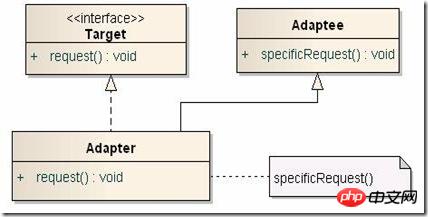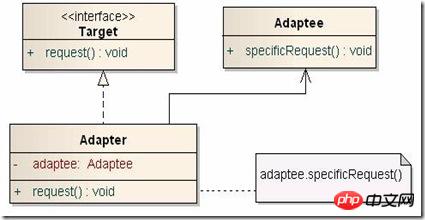Home >Backend Development >PHP Tutorial >Introduction to php adapter pattern
Introduction to php adapter pattern
- 怪我咯Original
- 2017-07-05 10:19:491934browse
Adapter (alias Wrapper) mode: Convert the interface of one class into the interface of another class expected by the customer. Adapters allow classes with incompatible interfaces to work seamlessly together
Key points:
1. Adapter pattern is mainly used in situations where "you want to reuse some existing classes, but the interface is inconsistent with the requirements of the reuse environment", in the aspects of legacy code reuse, class librarymigration, etc. very useful.
2. The adapter pattern has two implementation structures: object adapter and class adapter. However, the class adapter adopts the "multiple inheritance" implementation method, which brings undesirable high coupling, so it is generally not used. Recommended Use. The object adapter adopts the "object combination" method, which is more in line with the spirit of loose coupling.
Implementation:

public interface Target { void request();}Adaptee: Now requires adaptation The existing interface
public class Adaptee{ public void specificRequest(){}}Adapter: Adapt the Adaptee interface and the Target interface
public class Adapter implements Target{ public Adapter(Adaptee adaptee) { super(); this.adaptee = adaptee; } public void request() { adaptee.specificRequest(); } private Adaptee adaptee;}Applicability:1. The system needs to use existing classes, This type of interface does not meet the needs of the system. 2. Want to create a class that can be reused to work with some classes that are not much related to each other, including some classes that may be introduced in the future. These source classes do not necessarily have complex interfaces. 3. (For object adapters) In the design, it is necessary to change the interfaces of multiple existing subclasses. If you use the class adapter pattern, you must make an adapter for each subclass, and this Not very practical. Effects, advantages and disadvantages: For class adapters: 1. Use a specific Adapter class to match Adaptee and Target. The result is that when we want to match a class and all its subclasses, the class Adapter will not do the job. 2. Allow Adapter to override (redefine) some behaviors of Adaptee, because Adapter is a subclass of Adaptee.
For object adapters: 1. Allow an Adapter to work with multiple Adaptee, that is, the Adaptee itself and all its subclasses (if there are subclasses) at the same time. Adapter can also add functions to all Adaptees at once. 2. Makes it difficult to override (redefine) the behavior of Adaptee. If you must override the Adaptee method, you have to first make a subclass of Adaptee to override the Adaptee method, and then use this subclass as the real Adaptee source for adaptation.The above is the detailed content of Introduction to php adapter pattern. For more information, please follow other related articles on the PHP Chinese website!

